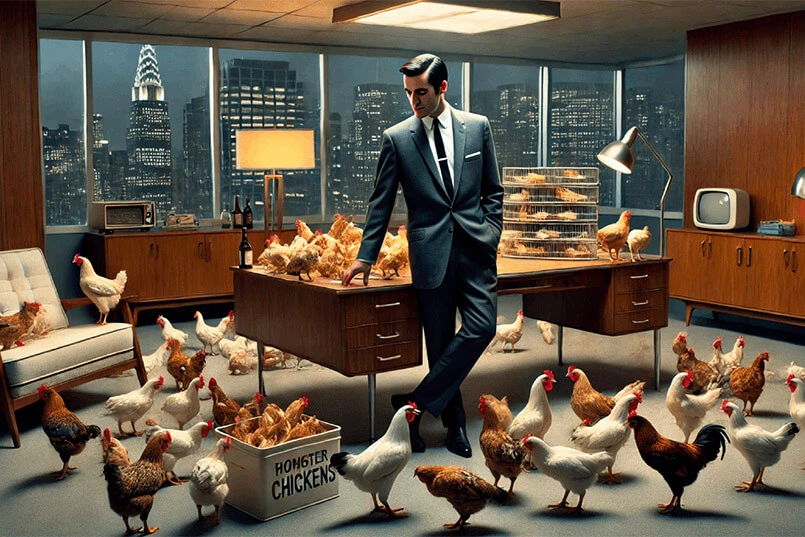The human brain processes images 60,000 times faster than text, which justifies using imagery. However, the brains of the person telling a story and the one listening to it synchronize and create a connection.
That’s why good stories make us empathize with the storyteller. This empathy releases feel-good chemicals in your brain, and the more we get, the more trustworthy we view the storyteller.
Weaving together a good story
What would Mark Twain make of the average agency’s ‘sizzle’ reel?
“I like a good story well told” (Mark Twain), and good stories tend to have a beginning, middle and end and engage your emotions throughout.
Twain didn’t need specialist behavioural science researchers to assert the importance of storytelling. Nevertheless, they do assert, with scientific facts and convincing case studies.
Twain also didn’t have access to much imagery or video. But, of course, he’d have appreciated the power of these added elements.
AdForum’s sizzle reel showcase – hot or not?
Having recently attended AdForum this year, I had cause on the plane home to consider what had been hot, what had fallen flat and why.
The intensity of seeing 18 back-to-back sets of credentials, which included sizzle reels, highlighted not just what had cut through and was memorable but what many clients have confided in the past “too much work, too fast a pace, be more selective relevant to me”.
Unlike E M Forster’s Howard’s End central thought – ‘only connect’, agencies should have a core concept, that is, their positioning, clearly highlighted in their reel; this was, and is generally, absent, sadly missing or generic to the industry.
Sizzle Archetypes
The smarter agencies tend to create tailored sizzle reels for each pitch – reels tweaked to the interests of the client in question.
But based on what we see in countless pitches, usually more than 350 agency credentials presentations a year – and what we saw in AdForum – sizzle reels can be categorized into four types:
- The music video clip – an upbeat music track (usually used without copyright clearance) with various images cut to the track at the speed of light that of themselves would never make a proper agency showreel.
- Talking heads – various agency personnel (let’s talk about ourselves, again) and perhaps occasionally the odd clients (far more convincing talking third-party endorsement) to camera
- It’s all about us – Usually disjointed, doesn’t show the benefit to the client and rarely a narrative of the agency’s positioning.
- ‘A day in the life of the agency’ – a vox populi piece highlighting the agency’s people and their typical day – is tightly edited to minimise the boring bits.
The Danger of a Bad Reel
So why is the sizzle reel such a staple in the industry? Has anyone considered whether this is the most convincing way to get insight into an agency’s best work from its clients or prospects?
Why are agencies, who are so creative, sticking to the same formats? Do they know it works? Have they tested anything different (good old direct marketing technique)?
Agencies put a lot of work into sizzle reels. The expectation is that the reel can act as a powerful selling tool, producing an emotional response in the potential clients it is aimed at.
Yet the danger of the average sizzle reel is that it can ultimately end up without a compelling thread – or at least no thread visible to the audience. Only the producers and the agency understand the story the reel is trying to tell.
Even if the model is a good visual precis, what about the messaging? What impression is the viewer left with? Also, if everyone does it, how does yours stand out? Is it because everyone is simply following everyone else?
Make sure you think hard enough about the reels they put together, using a clear brief as you would with a client before you book the edit suite. You could consider the following.
- Do you have a consistent story/ Is your work consistent enough to create a story?
Ideally, your work should reinforce your positioning or weave this in to demonstrate and prove your point of difference. Leave the client a clear view of why you should be considered on their pitch list.
- How are you going to capture the client’s attention?
How can you tell the story to capture everyone’s attention? There is more than one way to tell that story. We’ve found it’s better to tell a few stories than too many – less is more. Equally, think about several edits for use. Just as with cordon bleu cooking, you savour the good stuff.
- Prioritise telling your own story.
Make sure it’s properly planned into your work schedule. Like many agency sales materials, those selling the agency to clients can go on the back burner and be produced only when a particular requirement comes up, just like the new website, the latest version of the credentials, the up-to-date sizzle reel, case studies and some award entries. Paid client work is always important, but so is being proactive to get clients to know about and to want to buy your services.
What makes a good sizzle reel?
TrinityP3 has had the opportunity of reviewing a wide variety of credentials, including hundreds of sizzle reels globally.
Our suggestions, having seen the best and the worst, would be:
The Best
- A sizzle reel can engage for longer if it’s an engaging story.
- Get someone else to sell the agency for you – this can be more convincing. Happy CMO testimonials get cut through and are less common. And don’t worry about the impact on lengthening the timing of the reel.
- It’s not all about the work, people buy people, and that’s the reason for another industry norm, the chemistry session.
- The agency’s impact can go beyond response rates into the client’s business, even crafting products within their sector.
How to improve your Sizzle reel
- Reduce, reduce, reduce. It is better to show less work well.
- Weave a story together from the work if you will show more than a few campaigns.
- Is there something unique or quirky that makes your agency stand out that you can capture?
- Is your agency positioning clear, even as a strapline?
- Clients are looking for a marketing budget well spent. There are so many ways you can show business impact; adding to their business model, changing the way they talk to customers through their customer services scripts and technology, and even getting siloed departments working together.
- Wherever possible, tailor the reel to the project. It doesn’t have to be huge – it could just be dropping or moving specific case studies around to fit the client better.
Like any good novel, you don’t want your reel to trail off and leave the audience unsatisfied. So make the last case study your most memorable, or leave them with a cliffhanger so they want to know more about how you can specifically help them.
Learn more about how TrinityP3 can provide expert advice and feedback on your agency credentials presentation and positioning here.




